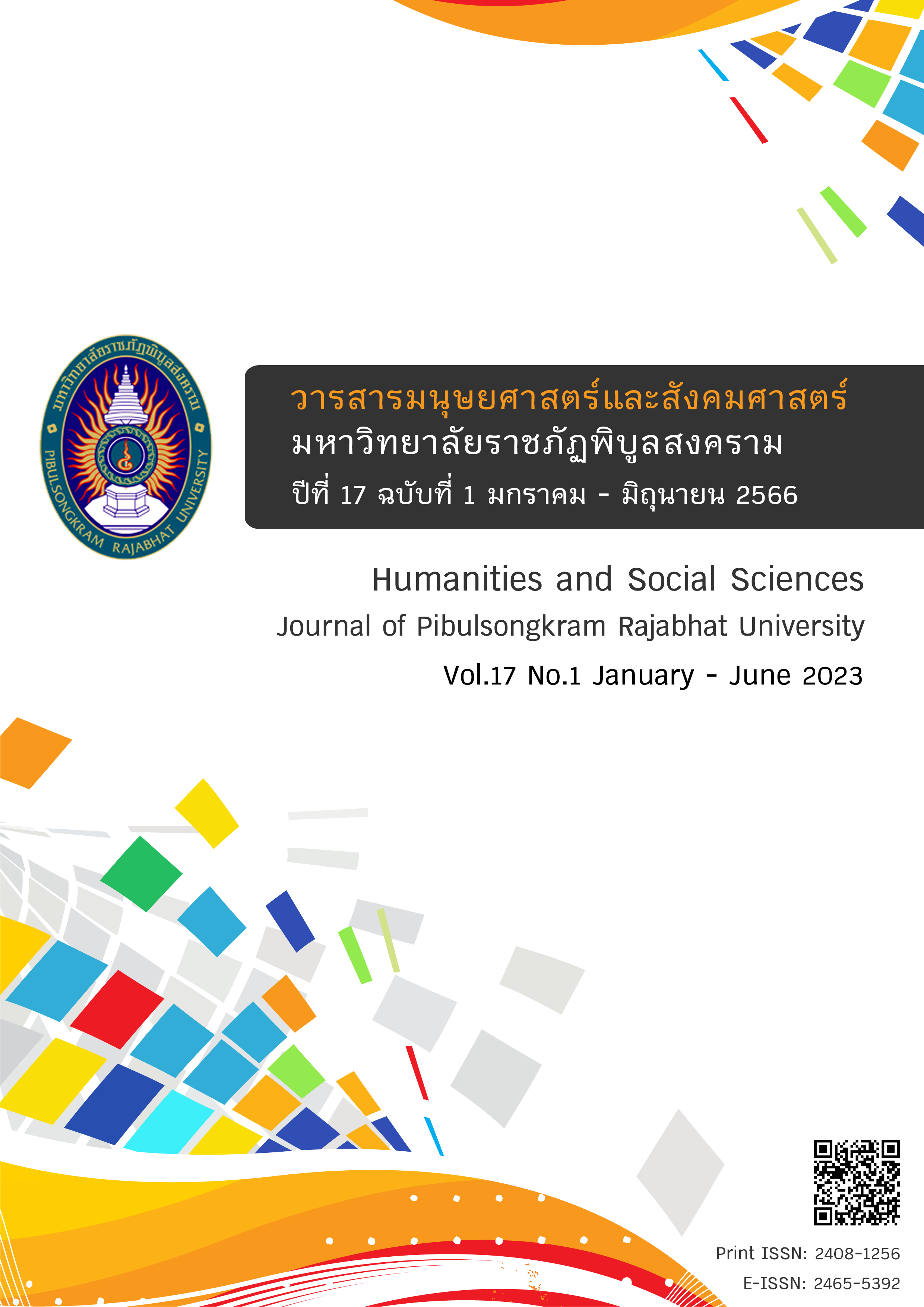บุพปัจจัยของความผูกพันในกลุ่ม ความภูมิใจในกลุ่ม และความไว้วางใจในสมาชิกที่ผลต่อความภักดีของผู้ซื้อบนเว็บไซต์โชเซียลเน็ตเวิร์ค
DOI:
https://doi.org/10.14456/psruhss.2023.4คำสำคัญ:
ความภักดีของผู้ซื้อ , ความผูกพันในกลุ่ม , ความภูมิใจในกลุ่ม , ความไว้วางใจในสมาชิกบทคัดย่อ
การวิจัยนี้มีวัตถุประสงค์คือเพื่อศึกษาโมเดลความภักดีของผู้ซื้อที่เกิดจากความผูกพันในกลุ่ม ความภูมิใจในกลุ่ม และความไว้วางใจในสมาชิก เป็นการวิจัยเชิงปริมาณและเก็บรวบรวมข้อมูลจากกลุ่มตัวอย่างจากผู้ซื้อสินค้าบนเว็บไซต์โซเชียลเน็ตเวิร์ค 519 คน วิเคราะห์ข้อมูลตัวแบบสมการโครงสร้าง (SEM) ด้วยโปรแกรม AMOS ผลการวิจัยพบว่าความผูกพันในกลุ่ม ความภูมิใจในกลุ่ม และความไว้วางใจในสมาชิก มีอิทธิพลทางตรงต่อความภักดีของผู้ซื้อบนเว็บไซต์โซเชียลเน็ตเวิร์ค อย่างมีนัยสำคัญทางสถิติ (p < .05)
References
Audrain-Pontevia, A. F., N’Goala, G., & Poncin, I. (2013). A good deal online: The Impacts of acquisition and transaction value on E-satisfaction and E-loyalty. Journal of Retailing and Consumer Services, 20(5), 445-452.
Brodie, R. J., Ilic, A., Juric, B., & Hollebeek, L. (2013). Consumer engagement in a virtual brand community: An exploratory analysis. Journal of business research, 66(1), 105-114.
Cai, S., & Xu, Y. (2006). Effects of outcome, process and shopping enjoyment on online consumer behaviour. Electronic Commerce research and applications, 5(4), 272-281.
Cheng, Z. C., & Guo, T. C. (2015). The formation of social identity and self-identity based on knowledge contribution in virtual communities: An inductive route model. Computers in Human Behavior, 43, 229-241.
Cheung, C. M., & Lee, M. K. (2010). A theoretical model of intentional social action in online social networks. Decision support systems, 49(1), 24-30.
Chiu, C-H., Cheng, H-L., Huang, H-Y, & Chen, C-F. (2013). Exploring individuals’ subjective well-being and loyalty towards social network sites from the perspective of network externalities: The Facebook use. International journal of information management, 33, 539-552.
Comrey, A. L., & Lee, H. B. (1992). A first course in factor analysis. Hillsdals, NJ: Erlbaum.
Cyr, D., Head, M., & Ivanov, A. (2009). Perceived interactivity leading to e-loyalty: Development of a model for cognitive–affective user responses. International Journal of Human-computer studies, 67(10), 850-869.
Durmuş, B., Ulusu, Y., & Erdem, Ş. (2013). Which dimensions affect private shopping e-customer loyalty?. Procedia-Social and Behavioral Sciences, 99, 420-427.
Ellemers, N., Kortekaas, P., & Ouwerkerk, J. W. (1999). Self‐categorisation, commitment to the group and group self‐esteem as related but distinct aspects of social identity. European journal of social psychology, 29(2‐3), 371-389.
Field, A. P. 2005). Discovering statistics using SPSS (2 ed.). Thousand Okes, CA: Sage Publications.
Gamboa, A. M., & Gonçalves, H. M. (2014). Customer loyalty through social networks: Lessons from Zara on Facebook. Business horizons, 57(6), 709-717.
Gefen, D., Straub, D., & Boudreau, M. C. (2000). Structural equation modeling and regression: Guidelines for research practice. Communications of the association for information systems, 4(1), 7.
Hair, J. F., Black, W. C., Babin, B. J. & Anderson, R. E. (2010). Multivariate Data Analysis (7th ed.). Upper Saddle River, NJ: Prentice Hall.
Hsu, C. P., Chiang, Y. F., & Huang, H. C. (2012). How experience‐driven community identification generates trust and engagement. Online Information Review, 36(1), 72-88.
Laroche, M., Habibi, M. R., Richard, M. O., & Sankaranarayanan, R. (2012). The effects of social media based brand communities on brand community markers, value creation practices, brand trust and brand loyalty. Computers in human behavior, 28(5), 1755-1767.
Li, D. C. (2011). Online social network acceptance: a social perspective. Internet Research, 21(5), 562-580.
Lim, J. S., Hwang, Y., Kim, S., & Biocca, F. A. (2015). How social media engagement leads to sports channel loyalty: Mediating roles of social presence and channel commitment. Computers in Human Behavior, 46, 158-167.
Lin, H. H., & Wang, Y. S. (2006). An examination of the determinants of customer loyalty in mobile commerce contexts. Information & management, 43(3), 271-282.
Lu, Y., Zhao, L., & Wang, B. (2010). From virtual community members to C2C e-commerce buyers: Trust in virtual communities and its effect on consumers’ purchase intention. Electronic commerce research and applications, 9(4), 346-360.
Narakorn, P., & Seesupan, T. (2018). The influence of social network site identity, active control, flow, trust in members and customer loyalty of Facebooks users. Silpakorn University Journal, 38(2), 121-145.
Narakorn, P., & Seesupan, T. (2018). Trust in seller catalyst social commerce constructs to continuance intention. Journal of Business Administration, 41(159), 24-44.
Nunnally, J. C. (1978). Psychometric Theory (2nd ed.). McGraw-Hill, NY: New York.
Seesupan, T., & Narakorn, P. (2018). The influence of social commerce, social support, satisfaction, commitment and trust to intention to co-creation in brand and continuance intention. Humanities, Arts and Social Sciences Studies, 18(1), 209-235.
Srinivasan, S. S., Anderson, R., & Ponnavolu, K. (2002). Customer loyalty in e-commerce: an exploration of its antecedents and consequences. Journal of retailing, 78(1), 41-50.
Svensson, G. (2001). Extending trust and mutual trust in business relationships towards a synchronised trust chain in marketing channels. Management Decision, 39(6), 431-440.
Tsiotsou, R. H. (2015). The role of social and parasocial relationships on social networking sites loyalty. Computers in human behavior, 48, 401-414.
Wang, H., Meng, Y., & Wang, W. (2013). The role of perceived interactivity in virtual communities: building trust and increasing stickiness. Connection Science, 25(1), 55-73.
Downloads
เผยแพร่แล้ว
How to Cite
ฉบับ
บท
License
Copyright (c) 2022 วารสารมนุษยศาสตร์และสังคมศาสตร์ มหาวิทยาลัยราชภัฏพิบูลสงคราม

This work is licensed under a Creative Commons Attribution-NonCommercial-NoDerivatives 4.0 International License.
บทความหรือข้อคิดเห็นใดใดที่ปรากฏในวารสารมนุษยศาสตร์และสังคมศาสตร์ มหาวิทยาลัยราชภัฏพิบูลสงครามเป็นวรรณกรรมของผู้เขียน ซึ่งบรรณาธิการไม่จำเป็นต้องเห็นด้วย บทความที่ได้รับการตีพิมพ์เป็นลิขสิทธิ์ของวารสารมนุษยศาสตร์และสังคมศาสตร์ มหาวิทยาลัยราชภัฏพิบูลสงคราม








